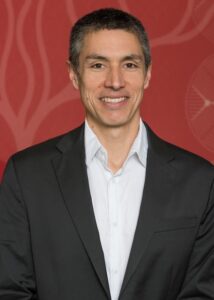Resource competition predicts assembly of gut commensals
KC Huang, PhD
Professor of Bioengineering and Microbiology & Immunology,
Stanford University
Friday, April 14th at 11:45 am
In-Person in SMBB 2650!

Microbiota dynamics arise from a plethora of interspecies interactions, including resource competition, cross-feeding, and pH modulation. The individual contributions of these mechanisms are challenging to untangle, especially in natural or complex laboratory environments where the landscape of resource competition is unclear. Here, we developed a framework to estimate the extent of multi-species niche overlaps by combining metabolomics data of individual species, growth measurements in pairwise spent media, and mathematical models. When applied to an in vitro model system of human gut commensals in complex media, our framework revealed that a simple model of resource competition described most pairwise interactions. By grouping metabolomic features depleted by the same set of species, we constructed a coarse-grained consumer-resource model that predicted assembly compositions to reasonable accuracy. Moreover, deviations from model predictions enabled us to identify and incorporate into the model additional interactions, including pH-mediated effects and cross-feeding, which improved model performance. In sum, our work provides an experimental and theoretical framework to dissect microbial interactions in complex in vitro environments.
KC Huang was an undergraduate Physics and Mathematics major in Page House at Caltech, and spent a year as a Churchill Scholar at Cambridge University working with Dr. Guna Rajagopal on Quantum Monte Carlo simulations of water cluster formation. He received his PhD from MIT working with Prof. John Joannopoulos on electromagnetic flux localization in polaritonic photonic crystals and the control of melting at semiconductor surfaces using nanoscale coatings. During a short summer internship at NEC Research Labs, he became interested in self-organization in biological systems, and moved on to a postdoc with Prof. Ned Wingreen in the Department of Molecular Biology at Princeton working on the relationships among cell shape detection, determination, and maintenance in bacteria. His lab is currently situated in the departments of Bioengineering and Microbiology & Immunology at Stanford, and his current interests include cell division, membrane organization, cell wall biogenesis, and the organizational principles of bacterial communities. He has been director of the Biophysics Graduate Program since 2015, and the chair of the DEI committee for the Aspen Center for Physics board since 2020.
Biomedical Engineering Seminar Series
Bioengineering Elevated Talks: Celebrating 50 years of the Department of
Biomedical Engineering at the University of Utah